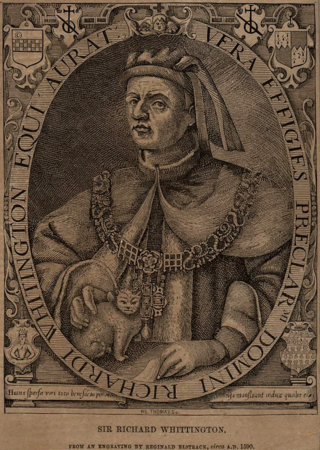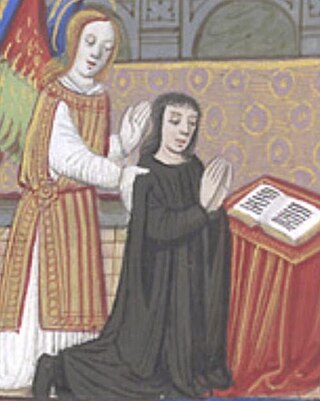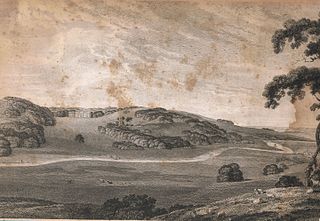
Sir Richard Hankford (1397-1431) was an English landowner and soldier from Devon. [2]

Sir Richard Hankford (1397-1431) was an English landowner and soldier from Devon. [2]
Born about 21 July 1397, he was the son of Richard Hankford (died 1419), [2] MP for Devon in 1414 and 1416, [3] and his wife Thomasine Stapledon (died before 1419), daughter and sole heiress of Sir Richard Stapledion, of Norton Fitzwarren and Nonnington in Somerset. [2]
After the death of his father in 1419, he inherited his late mother's lands and in 1420 the lands brought to him by his wife, followed in 1424 by the lands of his paternal grandfather, Sir William Hankford (died 1423) KB, of Annery in Devon, Chief Justice of the King's Bench. Further landholdings came in 1425, when he and his wife inherited the estates of her grandmother Elizabeth Cogan (died 1397) that had been held by her widower Sir Hugh Courtenay. He served with the English forces in France during the Hundred Years' War in the retinue of his brother-in-law Thomas Montacute, 4th Earl of Salisbury and was knighted at St Albans between 8 July and 6 October 1429. He died on 8 February 1431 aged 33, holding properties in Berkshire, Cornwall, Devon, Gloucestershire, Herefordshire, London (where he and his wife owned four retail shops in Holborn), Middlesex, Oxfordshire, Shropshire, Somerset; Staffordshire, Wiltshire and Yorkshire. [2]
At some time before 1420 he married Elizabeth FitzWarin (died before 16 January 1428), daughter of Fulk FitzWarin, 6th Baron FitzWarin (1389–1407) and sole heiress of her brother Fulk FitzWarin, 7th Baron FitzWarin (1406–1420). [2] They had three daughters:
Elizabeth had died by 16 January 1428 and he then married Anne Montagu (died 1457), daughter of the executed John Montagu, 3rd Earl of Salisbury and sister of his patron, the 4th Earl. [2] They had one daughter:
His widow Anne married again to Sir Lewis John (died 1442) and then to John Holland, 2nd Duke of Exeter (died 1447). She was buried with her third husband in the church of St Katharine by the Tower in the City of London. [2]

Richard Whittington of the parish of St Michael Paternoster Royal, City of London, was an English merchant and a politician of the late medieval period. He is also the real-life inspiration for the English folk tale Dick Whittington and His Cat. He was four times Lord Mayor of London, a member of parliament and a Sheriff of London. In his lifetime he financed a number of public projects, such as drainage systems in poor areas of medieval London, and a hospital ward for unmarried mothers. He bequeathed his fortune to form the Charity of Sir Richard Whittington which, nearly 600 years later, continues to assist people in need.
Alice Montacute was an English noblewoman and the suo jure 5th Countess of Salisbury, 6th Baroness Monthermer, and 7th and 4th Baroness Montagu, having succeeded to the titles in 1428.

Thomas Butler, 7th Earl of Ormond PC was the youngest son of James Butler, 4th Earl of Ormond. He was attainted, but restored by Henry VII's first Parliament in November 1485, and the statutes made at Westminster, by Edward IV, which declared him and his brothers traitors, were abrogated.

John Bourchier, 1st Earl of Bath was named Earl of Bath in 1536. He was feudal baron of Bampton in Devon.

John Bourchier, 2nd Earl of Bath was an Earl in the peerage of England. He also succeeded to the titles of 12th Baron FitzWarin, Baron Daubeney and 4th Count of Eu.

Fulk Bourchier, 10th Baron FitzWarin was the son and heir of William Bourchier, 9th Baron FitzWarin (1407–1470) and the father of John Bourchier, 1st Earl of Bath. He was feudal baron of Bampton in Devon.

Baron FitzWarin was a title in the Peerage of England created by writ of summons for Fulk V FitzWarin in 1295. His family had been magnates for nearly a century, at least since 1205 when his grandfather Fulk III FitzWarin obtained Whittington Castle near Oswestry, which was their main residence and the seat of a marcher lordship.

James Audley, 2nd Baron Audley of Heighley Castle, Staffordshire, was an English peer. He was the son and heir of Nicholas Audley, 1st Baron Audley (1289–1316) by his wife Joan Martin, who was the daughter of William Martin, feudal baron of Barnstaple, and Marcher Lord of Kemes. She was posthumously the eventual sole heiress of her brother William FitzMartin to Barnstaple and Kemes.
Sir William Hankford, also written Hankeford, of Annery in Devon, was an English lawyer who acted as Chief Justice of the King's Bench from 1413 until 1423.

John Montagu, 3rd Earl of Salisbury and 5th and 2nd Baron Montagu, KG was an English nobleman, one of the few who remained loyal to Richard II after Henry IV became king.

Thomas Montagu, 4th Earl of Salisbury, KG of Bisham in Berkshire, was an English nobleman and one of the most important English commanders during the Hundred Years' War.

Sir Hugh I Courtenay, of Haccombe in Devon, was Sheriff of Devon for 1418/19 and was thrice elected knight of the shire for Devon in 1395, 1397 and 1421. He was a grandson of Hugh de Courtenay, 2nd/10th Earl of Devon (1303–1377), was the younger brother of Edward de Courtenay, 3rd/11th Earl of Devon (1357–1419), "The Blind Earl", and was the grandfather of Edward Courtenay, 1st Earl of Devon (d.1509), KG, created Earl of Devon in 1485 by King Henry VII. He was the link between the senior line of the Courtenay Earls of Devon made extinct following the Battle of Tewkesbury in 1471 and the post-Wars of the Roses creation of a new Earldom for his grandson made in 1485 by King Henry VII.

Annery was an historic estate in the parish of Monkleigh, North Devon.

The feudal barony of Bampton was one of eight feudal baronies in Devonshire which existed during the mediaeval era, and had its caput at Bampton Castle within the manor of Bampton.

William Bourchier (1407–1470) jure uxoris 9th Baron FitzWarin, was an English nobleman. He was summoned to Parliament in 1448 as Baron FitzWarin in right of his wife Thomasine Hankford.

Ash in the parish of Braunton in North Devon is a historic estate listed in the Domesday Book. The present mansion, known as The Ash Barton estate is a Grade II* listed building.

The historic manor of Tawstock was situated in North Devon, in the hundred of Fremington, 2 miles south of Barnstaple, England. According to Pole the feudal baron of Barnstaple Henry de Tracy made Tawstock his seat, apparently having abandoned Barnstaple Castle as the chief residence of the barony. Many of the historic lords of the manor are commemorated by monuments in St Peter's Church, the parish church of Tawstock which in the opinion of Pevsner contains "the best collection in the county apart from those in the cathedral", and in the opinion of Hoskins "contains the finest collection of monuments in Devon and one of the most notable in England".
Margaret II Audley was a co-heiress to the feudal barony of Barnstaple in Devon, England.

Sir John Cary, of Devon, was a judge who rose to the position of Chief Baron of the Exchequer (1386–88) and served twice as Member of Parliament for Devon, on both occasions together with his brother, Sir William Cary, in 1363/64 and 1368/69.

Sir Robert Cary of Cockington, Devon, was twelve times Member of Parliament for Devon, in 1407, 1410, 1411, May 1413, April 1414, Mar. 1416, 1417, 1419, May 1421, 1422, 1425 and 1426. Much of his later life was devoted to regaining the many estates and other landholdings forfeited to the crown following his father's attainder in 1388. He was an esquire in the households of King Richard II (1377–1399) and of the latter's half-brother John Holland, 1st Duke of Exeter.